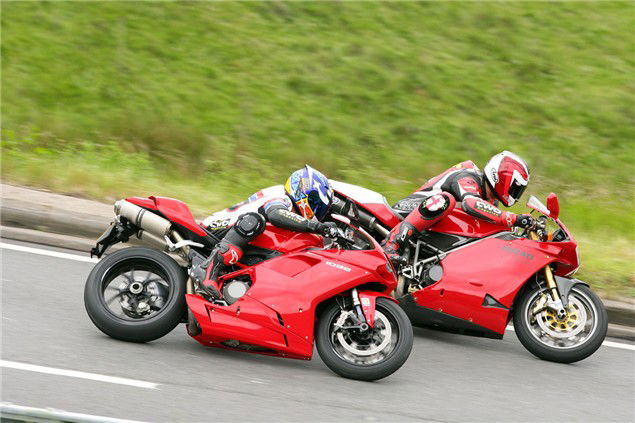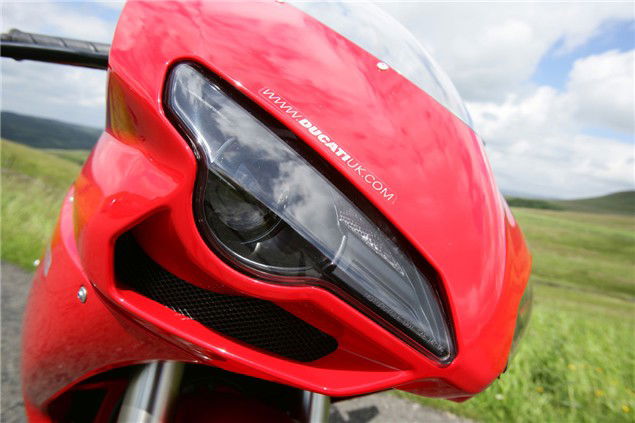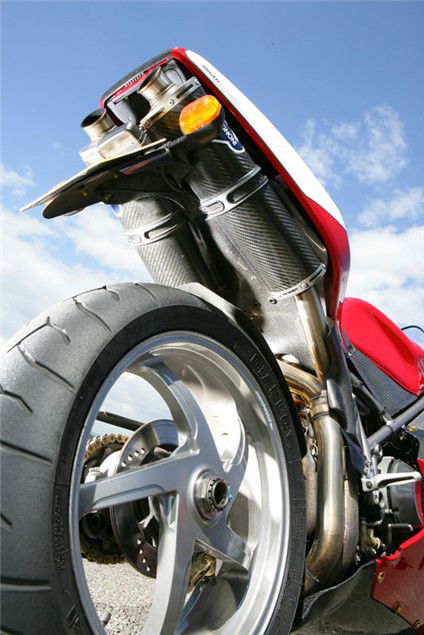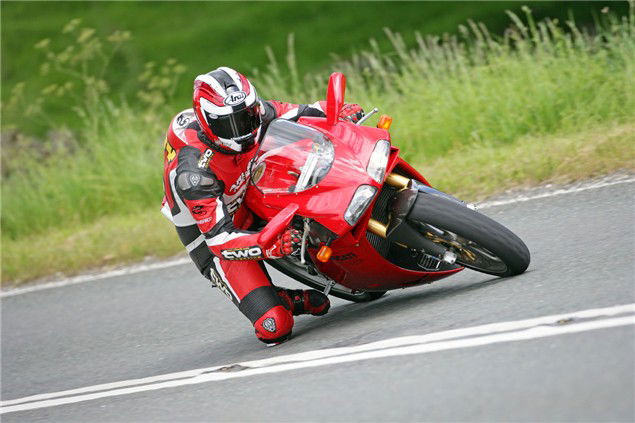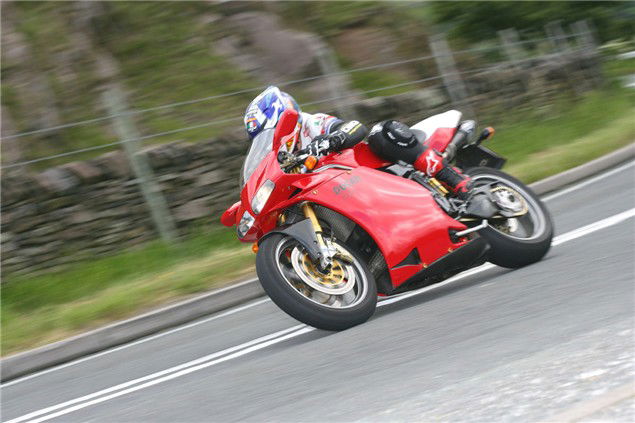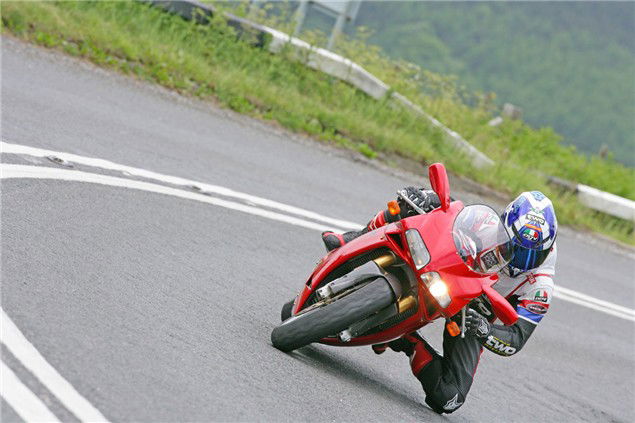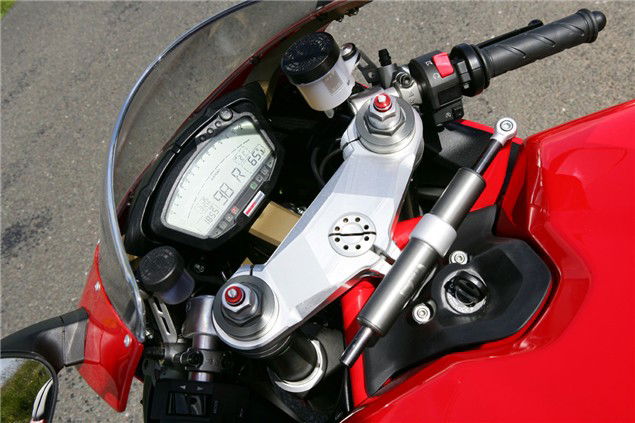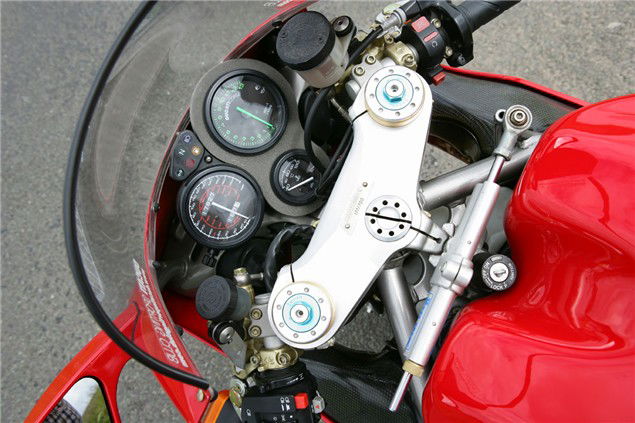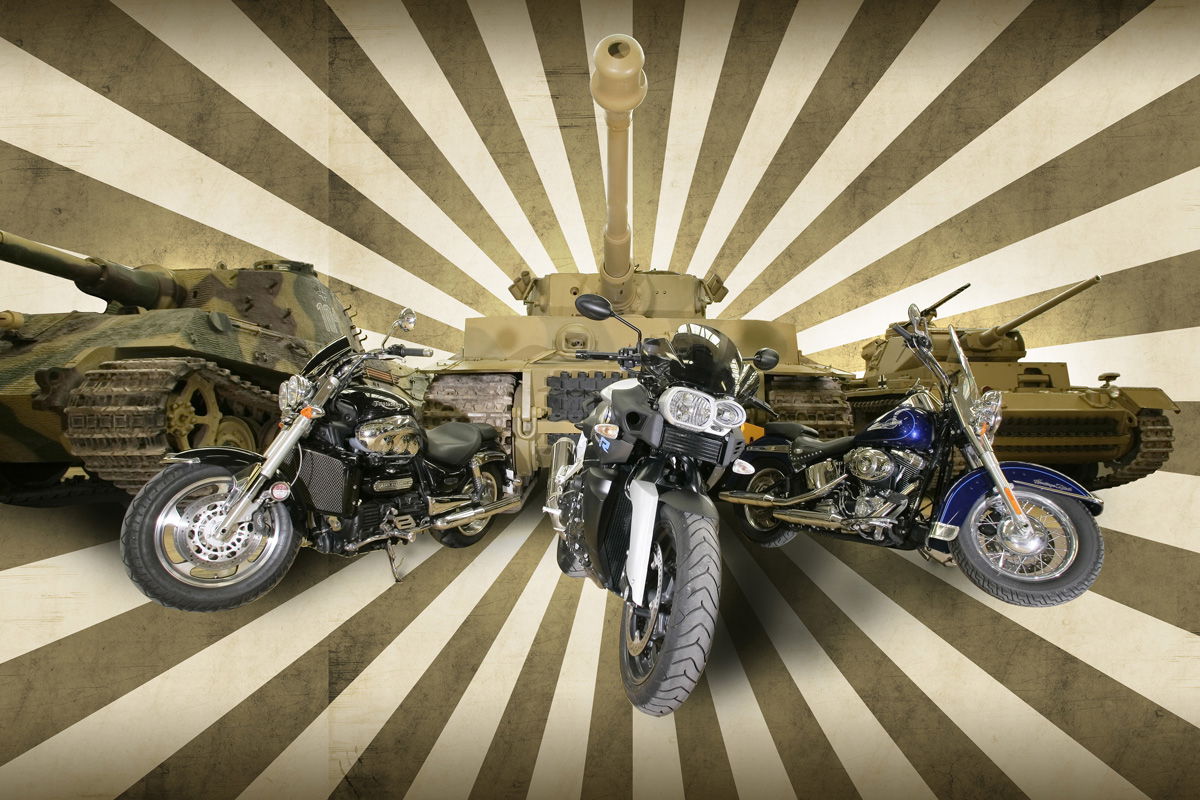Splitting Heirs: Ducati 998 v 1098
The Ducati 999 was just a stop-gap between the legendary 916 and the stunning new 1098. So for the first time ever, here are the two stablemates ridden head to head...
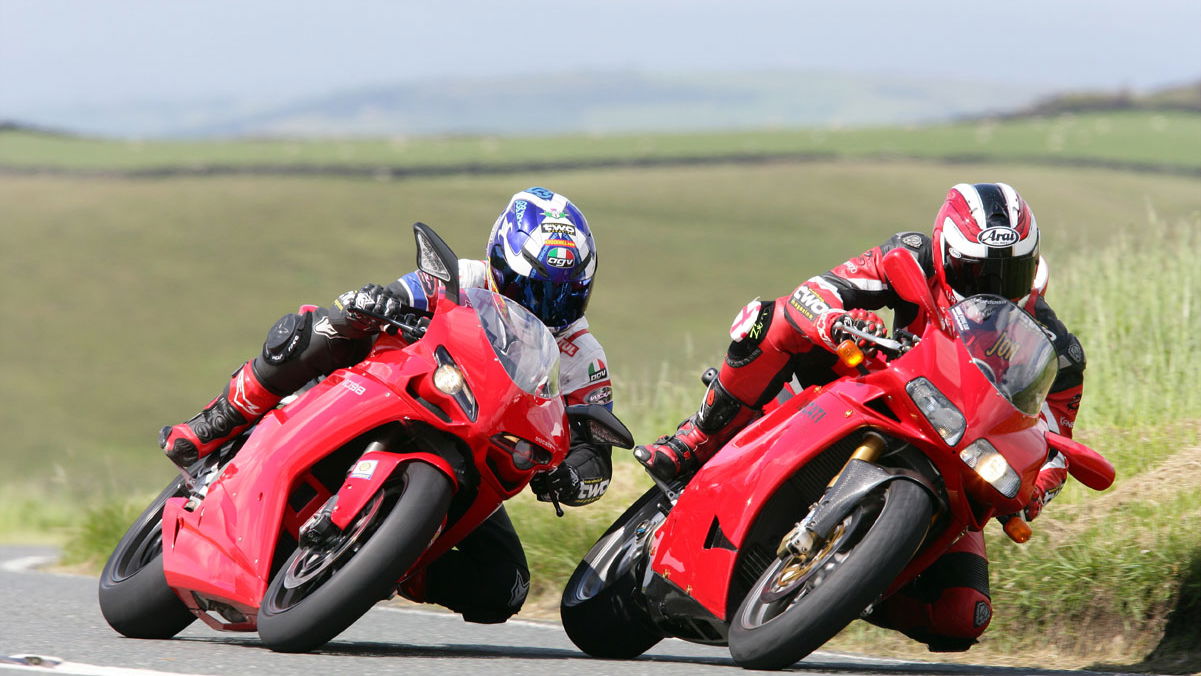
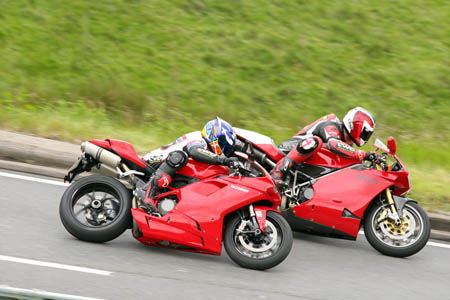
|
I have an ambition. I don't want to climb Everest, sleep with a supermodel or fly as a passenger in a Tornado. No, my ambition is fairly achievable. I just want to own a Ducati 916 (getting into the office before 10am would be nice - Ed).
For me the 916 is the defining bike of my adolescence. I was 17 when it was launched in 1994 and from that moment onwards I've always lusted after one. In my opinion the 916's design is perfect. It's like Porsche's 911, beautiful and totally timeless. But unlike the Porsche, which is beautiful because of its track-focused aggression, the 916 design oozes sex appeal.
Legend has it that its creator, Massimo Tamburini, designed the 916 to mimic the sensual curves of the female body when viewed from above. Only an Italian would think of doing this. But in truth there isn't a bad angle on the 916, it's just right in every detail from every side.
So right in fact that throughout its 10 year life the 916 remained virtually unchanged visually. As the years passed the wheels grew a few extra spokes, the fairing lost then gained vents and the logo increased in numbers but the bike's silhouette remained identical.
Then in 2002 the development reached its peak with what is, for me at least, the ultimate road going 916: the 998R. Only 700 were made worldwide and of that the UK's allocation was only 80. This wasn't just a few bolt-on goodies, this was the homologation special that had by then won six World Superbike Championships, 150 races, and had nearly made a household name of Carl Fogarty. More's the pity.
The 998R's engine is completely different to the rest of the 998 range. Being an R-model each motor is individually hand built with a balanced crank, but unlike the rest of the 998 models the 998R is actually 999cc thanks to a short stroke motor. Confused? Ducati needed more power from its race bikes and more power means more revs, but twins don't like being revved, so Ducati's solution was the short-stroke motor. The larger bore allowed Ducati to use bigger valves, gaining bhp, while the shorter stroke put less strain on the crank, allowing the motor to rev higher. These changes didn't come cheap. A 998R cost £18,995 compared to the 998S's £13,000.
Which is why I had resigned myself to the fact I would never get the chance to ride one. For a start they are so rare that owners are unlikely to let them out of their garage, let alone allow someone like myself to throw a leg over it and give it the berries. But, having ridden the new 1098, I had to know if Ducati's successor to the 916 (we will brush over the 999's sad existence) was really that much better than the ultimate 916.
Having located an owner who was prepared to let both Niall and myself lose on his 998R (thanks a million to Ray Jude) we took both bikes to the Peak District on a quiet midweek day to explore the delights of the two Ducatis in the perfect surrounding. The bikes looked absolutely stunning together, acres of lush red paint everywhere. I felt genuinely excited and very priveleged.
Before we went riding I had a nagging fear that I might have been expecting too much from the 998R. I've only ridden a 998S before and that was only for a very brief run. Most of my riding has been on the 999 range and much of my opinion that the 998 is a great bike is based around the fact it looks amazing - so therefore must go well. This day's riding could so easily ruin over a decade of dreaming, a bit like seeing Sam Fox naked today.
But from the moment the carbon Termignoni race cans boom into life, to the time you take the key out and take a final glance at the plaque telling you exactly which of the 700 bikes you have just ridden, the 998R is special. It's not until you ride it back to back with the 1098 you realise just how special it actually is.
The 998R still feels sharp and focused. It's hard to believe that this is a chassis that was designed 13 years ago because it still feels so good. Compared with the 1098 the 998R is slower to turn and requires more effort to get it on its ear, but once there is every bit as poised and balanced as the later Ducati. With the 1098 they've dialled out the lazy turn-in while retaining the mid-corner stability. After a quick spin on the new bike 998R owner Ray said it felt like the 1098 had power steering while the 998R was good old fashioned direct drive, which sums it up nicely.
There is no denying that the 1098 is a better bike in the conventional sense of the word. Sit on it and the riding position feels instantly natural, rather than the narrow and slightly cramped 998R. When it was launched in 1994 the 916 was the first Ducati that was really designed as a racebike then had lights added, so by the very nature of its design it has no compromises for the road. Little things like a lack of decent steering lock, fiddly ignition key location and firm seat are due to its design ethos. But there again, at least the 998R has mirrors that work. Back in 1994 mirrors were functional items, even on a Ducati sportsbike. Today they are little more than a necessary irritation that designers spend ages making look aesthetically pleasing rather than actually work, a point proven perfectly on the later bike.
The rider-position differences between the two bikes is a huge factor in how they ride, because the 1098's more natural and roomy seating position allows the rider to move around the bike easier, which in turn helps the bike turn. With the 998R I found myself getting caught in the bike and hanging off felt unnatural, mainly because of the tank's shape. The side of the fuel tank is very flat and your inner thigh doesn't rest naturally against it when you hang off, meaning you adopt a strange spread legged hang-off style. Look at the photos of Niall or myself riding and compare the knee position on the two bikes.
But the thing is, does it really matter that the 1098 is a better handling bike than the 998R? The thing with a bike such as this is how it makes you feel, and the 998R makes you feel very special indeed.
Aside from the exquisite styling touches (such as the occasional bit of lacquered carbon-fibre fairing poking out of the Ducati red paint) the 998R has the feeling of a true thoroughbred about it. The engine feels like it was designed to be on track. And not just as a bystander, this motor has Ducati Corse blood in its veins and is designed to be a winner.
I honestly expected to be a bit disappointed by the 998R's engine. After all, it's a five-year-old motor that is going up against a larger capacity and modern technology. But not a chance. The 998's engine is still a beauty, and very powerful. I couldn't believe it when I saw the power charts. The 998 is only 3bhp down on the 1098, which is amazing. Although it is lacking 8lb.ft of torque, something to be expected considering the capacity difference, this is still very impressive. But what the 998R's engine lacks in grunt is more than makes up for in outright character.
Unlike the 1098 the R has a truly frantic air about it. Although it has a thumping mid-range, the motor loves to be fed revs and has a raw and menacing feel. That's what I imagine a Ducati race bike would feel like, but Niall's the expert here having actually raced one of these bikes and he said it felt remarkably similar to his British Superbike GSE 996R. Compared to the 1098's lazy but still shockingly fast power delivery, the 998R does require more gear changes, more revs and more attention to exactly where in the power range you are, but personally I want that. I like the fact it makes me feel like Foggy (although without the crack-addict face) and I like the fact it's engaging to ride. As with the handling the 1098's engine is ultimately better when it comes to raw riding, but when it boils down to the emotion of the riding experience, the 998R rules the day.
Which is the dilemma when it comes to splitting these two bikes. There is no doubt that the 1098 is a better machine. It has the better engine, the better handling and the better brakes. But this isn't really a surprise, it's a brand new motorcycle that is using the latest technology. When you hand over your £11,250 you get what you pay for, the latest generation of Italian superbike. But you know what, I'd take the 998R over it any day, even though they cost almost the same money.
There is something just so special about the 998R. It still knocks the spots of any other bike when it comes to styling. Parked next to the 998R the 1098 looks fussy and over-engineered. The 998R is a model in less-is-more with subtle, natural beauty while the 1098 is a supermodel that has trimmed down and applied a bit of slap. I could look at the 998R for hours and still not get bored, the 1098 still has the hint of a Japanese bike about it hidden in its beauty.
Yes, some things do feel dated on the 998R. It does require more effort to turn, has a lazy feeling and doesn't stop quite as well. But the engine is so engaging to use with a sound that reminds me of sitting on a crowded bank at Brands in a sea of red cheering on Foggy to yet another World Superbike title. Even the clocks appeal to my retro-side, although the 1098's digital wizardry wows anyone who stops and looks at them.
The 916 is my childhood dream and up until this point my ambition was to own a 1994 916SP. It had to be the first, the purest and the father of the 916 family. Now I have a dilemma. The 998R is quite simply the ultimate 916 and having now had the privilege to ride one I want one, badly. While I reckon the 916SP would feel underpowered compared to modern bikes the 998R doesn't, even compared to the latest and greatest Bologna has to offer.
NIALL'S SECOND OPINION - 2007 1098
Total refinement is the best way to describe a comparison between these two machines.
The 1098's engine has less vibration and a much smoother power delivery, giving the impression it may not be as fast as the 998R, which is not the case. Although the motor is less linear than the 998R it is faster and the rush of power that appears around 6,000rpm throws you back in the seat and picks up the front. You have to be ready to short shift or skim the rear brake if you are in a hurry in 1st or 2nd!
When it comes to suspension the big advantage the 1098 has over the 998R is it seems to cope with all the high speed movement over bumps and undulations, but is also very stable at higher speeds. The riding position is roomier and doesn't seem to lock you in the bike as much, and is more comfortable on a long ride. The braking performance is quite close between the bikes, and you never get fed-up looking at the 1098's beautifully machined monobloc calipers. And beauty is what this bike is all about, from the best dash ever all the way back to the MotoGP style tail unit. Mind you when I first saw the 916 in 1994 I felt exactly the same!
NIALL'S SECOND OPINION - 2002 998R
My last season on a 916-body Ducati was with GSE aboard a 'customer' factory 996R in 2001 and this ride out in Buxton brought all the memories flooding back! It wasn't my best season, but my team mate Neil Hodgson won the BSB championship and a WSB title.
The 998R has the same raw feel as the full-spec racer with its instant throttle response and massive mid-range torque. I expected it to be a wheelie monster on the road but that's not the case, as although the front lifts in the first three gears you never have to back off the throttle as it immediately settles as the revs increase. I found the rear suspension a bit harsh for the Derbyshire roads but for smoother surfaces and track days it would be perfect. The front was the opposite and if anything felt soft under braking.
The brakes felt as strong as the exotic items on the 1098 but lacked the instant reaction, which you could argue may not be a bad thing on dodgy roads. The dash is of course pretty old fashioned now being totally analogue with wobbly needles but all part of this great Ducati era. It's funny because the 916 family has never become dated; it went straight to looking like a modern classic. Very clever.
SPECS | Ducati 998R TYPE - SUPERSPORTS | Ducati 1098 TYPE - SUPERSPORTS |

I have an ambition. I don't want to climb Everest, sleep with a supermodel or fly as a passenger in a Tornado. No, my ambition is fairly achievable. I just want to own a Ducati 916.
For me the 916 is the defining bike of my adolescence. I was 17 when it was launched in 1994 and from that moment onwards I've always lusted after one. In my opinion the 916's design is perfect. It's like Porsche's 911, beautiful and totally timeless. But unlike the Porsche, which is beautiful because of its track-focused aggression, the 916 design oozes sex appeal.
Legend has it that its creator, Massimo Tamburini, designed the 916 to mimic the sensual curves of the female body when viewed from above. Only an Italian would think of doing this. But in truth there isn't a bad angle on the 916, it's just right in every detail from every side.
So right in fact that throughout its 10 year life the 916 remained virtually unchanged visually. As the years passed the wheels grew a few extra spokes, the fairing lost then gained vents and the logo increased in numbers but the bike's silhouette remained identical.
Then in 2002 the development reached its peak with what is, for me at least, the ultimate road going 916: the 998R. Only 700 were made worldwide and of that the UK's allocation was only 80. This wasn't just a few bolt-on goodies, this was the homologation special that had by then won six World Superbike Championships, 150 races, and had nearly made a household name of Carl Fogarty. More's the pity.
The 998R's engine is completely different to the rest of the 998 range. Being an R-model each motor is individually hand built with a balanced crank, but unlike the rest of the 998 models the 998R is actually 999cc thanks to a short stroke motor. Confused? Ducati needed more power from its race bikes and more power means more revs, but twins don't like being revved, so Ducati's solution was the short-stroke motor. The larger bore allowed Ducati to use bigger valves, gaining bhp, while the shorter stroke put less strain on the crank, allowing the motor to rev higher. These changes didn't come cheap. A 998R cost £18,995 compared to the 998S's £13,000.
Which is why I had resigned myself to the fact I would never get the chance to ride one. For a start they are so rare that owners are unlikely to let them out of their garage, let alone allow someone like myself to throw a leg over it and give it the berries. But, having ridden the new 1098, I had to know if Ducati's successor to the 916 (we will brush over the 999's sad existence) was really that much better than the ultimate 916.
Having located an owner who was prepared to let both Niall and myself lose on his 998R (thanks a million to Ray Jude) we took both bikes to the Peak District on a quiet midweek day to explore the delights of the two Ducatis in the perfect surrounding. The bikes looked absolutely stunning together, acres of lush red paint everywhere. I felt genuinely excited and very priveleged.
Before we went riding I had a nagging fear that I might have been expecting too much from the 998R. I've only ridden a 998S before and that was only for a very brief run. Most of my riding has been on the 999 range and much of my opinion that the 998 is a great bike is based around the fact it looks amazing - so therefore must go well. This day's riding could so easily ruin over a decade of dreaming, a bit like seeing Sam Fox naked today.
But from the moment the carbon Termignoni race cans boom into life, to the time you take the key out and take a final glance at the plaque telling you exactly which of the 700 bikes you have just ridden, the 998R is special. It's not until you ride it back to back with the 1098 you realise just how special it actually is.
NIALL'S SECOND OPINION
2007 1098
Total refinement is the best way to describe a comparison between these two machines.
The 1098's engine has less vibration and a much smoother power delivery, giving the impression it may not be as fast as the 998R, which is not the case. Although the motor is less linear than the 998R it is faster and the rush of power that appears around 6,000rpm throws you back in the seat and picks up the front. You have to be ready to short shift or skim the rear brake if you are in a hurry in 1st or 2nd!
When it comes to suspension the big advantage the 1098 has over the 998R is it seems to cope with all the high speed movement over bumps and undulations, but is also very stable at higher speeds. The riding position is roomier and doesn't seem to lock you in the bike as much, and is more comfortable on a long ride. The braking performance is quite close between the bikes, and you never get fed-up looking at the 1098's beautifully machined monobloc calipers. And beauty is what this bike is all about, from the best dash ever all the way back to the MotoGP style tail unit. Mind you when I first saw the 916 in 1994 I felt exactly the same!
2002 998R
My last season on a 916-body Ducati was with GSE aboard a 'customer' factory 996R in 2001 and this ride out in Buxton brought all the memories flooding back! It wasn't my best season, but my team mate Neil Hodgson won the BSB championship and a WSB title.
The 998R has the same raw feel as the full-spec racer with its instant throttle response and massive mid-range torque. I expected it to be a wheelie monster on the road but that's not the case, as although the front lifts in the first three gears you never have to back off the throttle as it immediately settles as the revs increase. I found the rear suspension a bit harsh for the Derbyshire roads but for smoother surfaces and track days it would be perfect. The front was the opposite and if anything felt soft under braking.
The brakes felt as strong as the exotic items on the 1098 but lacked the instant reaction, which you could argue may not be a bad thing on dodgy roads. The dash is of course pretty old fashioned now being totally analogue with wobbly needles but all part of this great Ducati era. It's funny because the 916 family has never become dated; it went straight to looking like a modern classic. Very clever.
998 v 1098 - 2/2
The 998R still feels sharp and focused. It's hard to believe that this is a chassis that was designed 13 years ago because it still feels so good. Compared with the 1098 the 998R is slower to turn and requires more effort to get it on its ear, but once there is every bit as poised and balanced as the later Ducati. With the 1098 they've dialled out the lazy turn-in while retaining the mid-corner stability. After a quick spin on the new bike 998R owner Ray said it felt like the 1098 had power steering while the 998R was good old fashioned direct drive, which sums it up nicely.
There is no denying that the 1098 is a better bike in the conventional sense of the word. Sit on it and the riding position feels instantly natural, rather than the narrow and slightly cramped 998R. When it was launched in 1994 the 916 was the first Ducati that was really designed as a racebike then had lights added, so by the very nature of its design it has no compromises for the road. Little things like a lack of decent steering lock, fiddly ignition key location and firm seat are due to its design ethos. But there again, at least the 998R has mirrors that work. Back in 1994 mirrors were functional items, even on a Ducati sportsbike. Today they are little more than a necessary irritation that designers spend ages making look aesthetically pleasing rather than actually work, a point proven perfectly on the later bike.
The rider-position differences between the two bikes is a huge factor in how they ride, because the 1098's more natural and roomy seating position allows the rider to move around the bike easier, which in turn helps the bike turn. With the 998R I found myself getting caught in the bike and hanging off felt unnatural, mainly because of the tank's shape. The side of the fuel tank is very flat and your inner thigh doesn't rest naturally against it when you hang off, meaning you adopt a strange spread legged hang-off style. Look at the photos of Niall or myself riding and compare the knee position on the two bikes.
But the thing is, does it really matter that the 1098 is a better handling bike than the 998R? The thing with a bike such as this is how it makes you feel, and the 998R makes you feel very special indeed.
Aside from the exquisite styling touches (such as the occasional bit of lacquered carbon-fibre fairing poking out of the Ducati red paint) the 998R has the feeling of a true thoroughbred about it. The engine feels like it was designed to be on track. And not just as a bystander, this motor has Ducati Corse blood in its veins and is designed to be a winner.
I honestly expected to be a bit disappointed by the 998R's engine. After all, it's a five-year-old motor that is going up against a larger capacity and modern technology. But not a chance. The 998's engine is still a beauty, and very powerful. I couldn't believe it when I saw the power charts. The 998 is only 3bhp down on the 1098, which is amazing. Although it is lacking 8lb.ft of torque, something to be expected considering the capacity difference, this is still very impressive. But what the 998R's engine lacks in grunt is more than makes up for in outright character.
Unlike the 1098 the R has a truly frantic air about it. Although it has a thumping mid-range, the motor loves to be fed revs and has a raw and menacing feel. That's what I imagine a Ducati race bike would feel like, but Niall's the expert here having actually raced one of these bikes and he said it felt remarkably similar to his British Superbike GSE 996R. Compared to the 1098's lazy but still shockingly fast power delivery, the 998R does require more gear changes, more revs and more attention to exactly where in the power range you are, but personally I want that. I like the fact it makes me feel like Foggy (although without the crack-addict face) and I like the fact it's engaging to ride. As with the handling the 1098's engine is ultimately better when it comes to raw riding, but when it boils down to the emotion of the riding experience, the 998R rules the day.
Which is the dilemma when it comes to splitting these two bikes. There is no doubt that the 1098 is a better machine. It has the better engine, the better handling and the better brakes. But this isn't really a surprise, it's a brand new motorcycle that is using the latest technology. When you hand over your £11,250 you get what you pay for, the latest generation of Italian superbike. But you know what, I'd take the 998R over it any day, even though they cost almost the same money.
There is something just so special about the 998R. It still knocks the spots of any other bike when it comes to styling. Parked next to the 998R the 1098 looks fussy and over-engineered. The 998R is a model in less-is-more with subtle, natural beauty while the 1098 is a supermodel that has trimmed down and applied a bit of slap. I could look at the 998R for hours and still not get bored, the 1098 still has the hint of a Japanese bike about it hidden in its beauty.
Yes, some things do feel dated on the 998R. It does require more effort to turn, has a lazy feeling and doesn't stop quite as well. But the engine is so engaging to use with a sound that reminds me of sitting on a crowded bank at Brands in a sea of red cheering on Foggy to yet another World Superbike title. Even the clocks appeal to my retro-side, although the 1098's digital wizardry wows anyone who stops and looks at them.
The 916 is my childhood dream and up until this point my ambition was to own a 1994 916SP. It had to be the first, the purest and the father of the 916 family. Now I have a dilemma. The 998R is quite simply the ultimate 916 and having now had the privilege to ride one I want one, badly. While I reckon the 916SP would feel underpowered compared to modern bikes the 998R doesn't, even compared to the latest and greatest Bologna has to offer.
Emotion plays such a large part in Ducati ownership, it has to. With the modern Japanese bikes now offering so much in the way of standard equipment, Ducati has to set themselves aside by offering something the Japanese simply can't justify the extra cost, the problem with the 999 was that it was lacking in emotion, it wasn't inspirational and wasn't sexy. It looked like a bag of bits, the exhausts were ugly and it didn't have any passion. Riding it was like riding a Japanese interpretation of a Ducati, so it didn't sell. The 1098 goes a long way to restoring the balance and brings Ducati back to where it should be, at the forefront of emotional biking. But for me and, I think, nearly everyone else, the 998R was, and still is, the ultimate Ducati superbike. You shouldn't mess with perfection, and that's the 998R all over.
Specifications
SPECS 998R
TYPE - SUPERSPORTS
PRODUCTION DATE - 2002
PRICE NEW - £12,000 (USED)
ENGINE CAPACITY - 999cc
POWER - 138bhp@10,000rpm
TORQUE - 73.7lb.ft@8000rpm
WEIGHT - 195kg (WET)
SEAT HEIGHT - 790mm
FUEL CAPACITY - 17L
TOP SPEED - 174mph
SPECS 1098
TYPE - SUPERSPORTS
PRODUCTION DATE - 2007
PRICE NEW - £11,250
ENGINE CAPACITY - 1099cc
POWER - 141.2bhp@9400rpm
TORQUE - 81lb.ft@7800rpm
WEIGHT - 199kg (WET)
SEAT HEIGHT - 820mm
FUEL CAPACITY - 15.5L
TOP SPEED - 176.2mph
